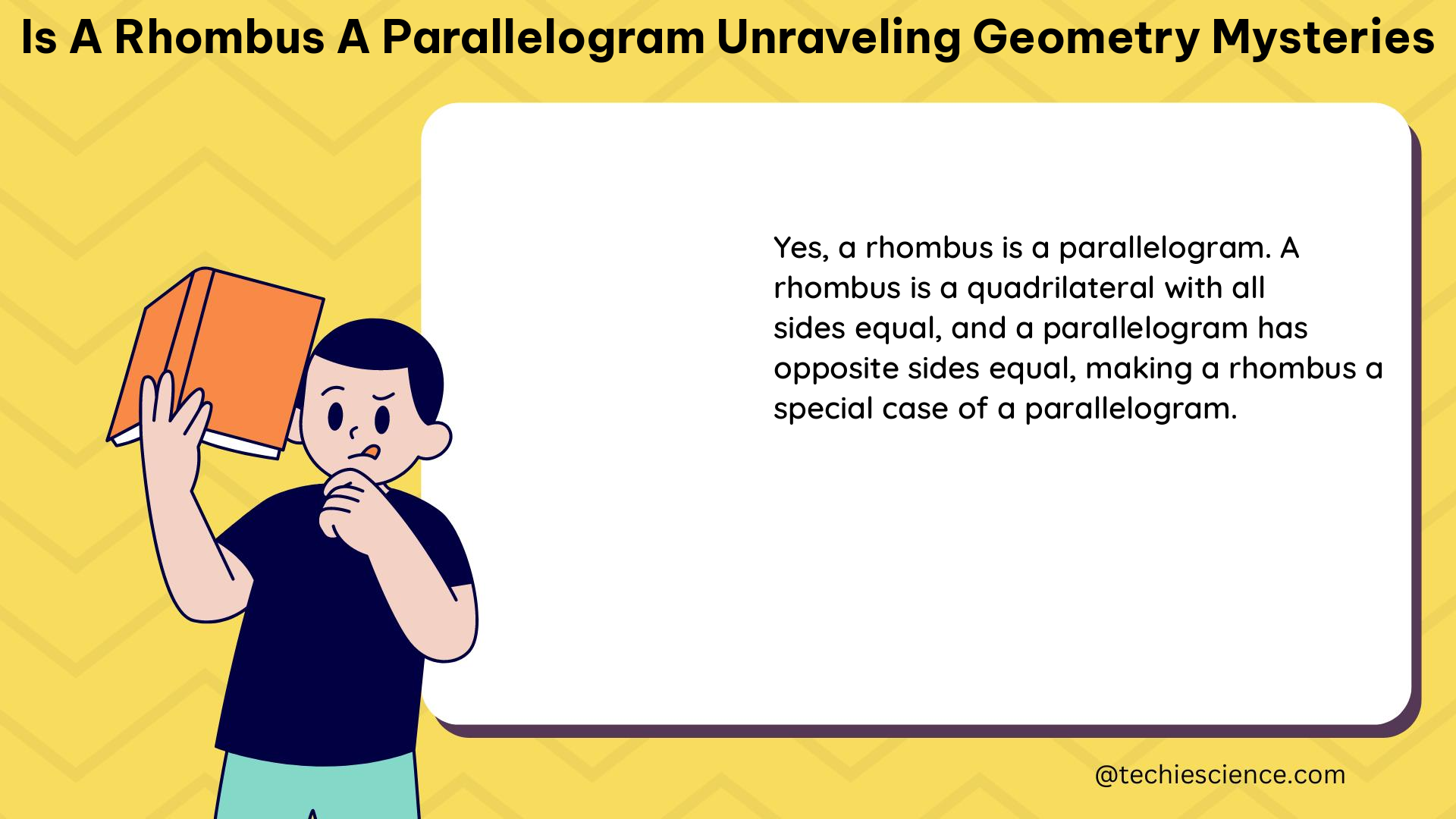A rhombus is a special type of parallelogram that has some unique properties and characteristics. Understanding the relationship between a rhombus and a parallelogram can help us unravel the mysteries of geometry and gain a deeper appreciation for the intricate world of shapes and their mathematical properties.
Defining a Rhombus and a Parallelogram
A parallelogram is a quadrilateral with two pairs of parallel sides. The opposite sides of a parallelogram are equal in length, and the opposite angles are also equal in measure. This means that a parallelogram can have a wide range of shapes and sizes, depending on the lengths of its sides and the measures of its angles.
On the other hand, a rhombus is a more specific type of parallelogram. A rhombus is defined as a quadrilateral with four equal sides. This means that a rhombus has two pairs of parallel sides, just like a parallelogram, but with the additional property that all four sides are equal in length.
Diagonals of a Rhombus

One of the key features that distinguishes a rhombus from a general parallelogram is the behavior of its diagonals. In a rhombus, the diagonals always bisect each other at right angles, forming four congruent right-angled triangles.
The diagonals of a rhombus can be used to calculate its area using the formula:
Area = (diagonal1 * diagonal2) / 2
Furthermore, the diagonals of a rhombus are related to its sides and angles by the following formulas:
Diagonal1 = √(2 * side^2)
Diagonal2 = 2 * side * cos(angle/2)
Where “side” refers to the length of any side of the rhombus, and “angle” refers to the measure of any angle.
Theorems and Properties of a Rhombus
Rhombi have several unique theorems and properties that set them apart from other types of parallelograms. Some of these include:
- Theorem 1: The diagonals of a rhombus are perpendicular to each other and bisect each other at right angles.
- Theorem 2: The diagonals of a rhombus divide the rhombus into four congruent right-angled triangles.
- Property 1: All four sides of a rhombus are equal in length.
- Property 2: The opposite sides of a rhombus are parallel and equal in length.
- Property 3: The opposite angles of a rhombus are equal in measure.
- Property 4: The diagonals of a rhombus bisect each other at right angles.
These theorems and properties are crucial in understanding the unique characteristics of a rhombus and how it differs from a general parallelogram.
Examples and Applications
Rhombi can be found in various real-world applications and natural phenomena. Some examples include:
- Architecture: Rhombus-shaped windows, roofs, and building designs are common in modern architecture.
- Engineering: Rhombus-shaped truss systems are used in the construction of bridges and other large structures.
- Biology: The shape of certain insect wings, such as those of dragonflies, can be approximated by a rhombus.
- Art and Design: Rhombus patterns and shapes are often used in textile designs, mosaics, and other artistic creations.
Understanding the properties of a rhombus can also be helpful in solving geometry problems and analyzing the behavior of other quadrilaterals.
Numerical Problems and Calculations
To further explore the relationship between a rhombus and a parallelogram, let’s consider some numerical problems and calculations:
- Problem 1: A rhombus has a side length of 6 cm. Calculate the lengths of its diagonals.
-
Solution: Using the formulas for the diagonals of a rhombus, we can calculate:
- Diagonal1 = √(2 * 6^2) = 8.49 cm
- Diagonal2 = 2 * 6 * cos(90°/2) = 8.49 cm
-
Problem 2: A parallelogram has side lengths of 8 cm and 12 cm, and an angle of 60° between the sides. Calculate the area of the parallelogram.
-
Solution: Using the formula for the area of a parallelogram, A = base * height, we can calculate:
- Height = 12 * sin(60°) = 10.39 cm
- Area = 8 * 10.39 = 83.12 cm^2
-
Problem 3: A rhombus has a diagonal1 of 10 cm and a diagonal2 of 8 cm. Calculate the length of the sides and the measure of the angles.
- Solution: Using the formulas for the diagonals of a rhombus, we can calculate:
- Side = √(10^2 + 8^2) / 2 = 6.32 cm
- Angle = 2 * acos(8 / (2 * 6.32)) = 60°
These examples demonstrate how the unique properties and formulas of a rhombus can be used to solve various geometry problems and explore the relationship between a rhombus and a parallelogram.
Conclusion
In conclusion, a rhombus is a special type of parallelogram with the additional property of having four equal sides. The diagonals of a rhombus bisect each other at right angles, dividing the rhombus into four congruent right-angled triangles. Understanding the theorems, properties, and formulas associated with a rhombus can help us unravel the mysteries of geometry and solve a wide range of problems involving quadrilaterals.
References
- Roget’s Thesaurus of English Words and Phrases. (n.d.). Retrieved from https://www.gutenberg.org/files/22/old/roget15a.txt
- Is it a rhombus or just a parallelogram? (2023, April 10). Retrieved from https://www.reddit.com/r/askmath/comments/10wj7ft/help_is_it_a_rhombus_or_just_a_parallelogram/
- NIST Special Publication 958. (n.d.). Retrieved from https://xdevs.com/doc/_Metrology/NIST/nist-sp-958.pdf

The lambdageeks.com Core SME Team is a group of experienced subject matter experts from diverse scientific and technical fields including Physics, Chemistry, Technology,Electronics & Electrical Engineering, Automotive, Mechanical Engineering. Our team collaborates to create high-quality, well-researched articles on a wide range of science and technology topics for the lambdageeks.com website.
All Our Senior SME are having more than 7 Years of experience in the respective fields . They are either Working Industry Professionals or assocaited With different Universities. Refer Our Authors Page to get to know About our Core SMEs.